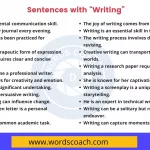Grammar is the invisible glue that holds language together. Whether you’re writing an email, chatting with friends, or crafting a novel, understanding English grammar ensures clarity and confidence. Let’s break down what grammar is, explore its key components, and share actionable tips to sharpen your skills—with plenty of examples!
What is the definition of English grammar?
English grammar is the set of structural rules governing how words combine to form meaningful sentences. It dictates everything from verb tenses to punctuation, helping us communicate ideas precisely. Think of it as the “rulebook” for English, ensuring we’re all on the same page when we speak or write.
English Grammar definition for children:
The book from which we can know the rules of speaking, reading, and writing English correctly is called English grammar.
Key Components of Grammar
- Syntax: The arrangement of words in a sentence (e.g., She reads books vs. Books she reads).
- Morphology: How words change form (e.g., run → ran; happy → happiness).
- Semantics: The meaning behind words and sentences (e.g., “I’m freezing!” implies cold, not literal ice).
Essentials of English Grammar
- Language and Grammar
- Sound, Letters, and Alphabet
- Vowels and Consonants
- Word and Syllable
- Divisions of Grammar
Parts of Speech
Every word in English belongs to a category that defines its role.
| Part of Speech | Function | Examples |
|---|---|---|
| Noun | Names a person, place, or thing | dog, Paris, happiness |
| Verb | Expresses action or state | run, is, think |
| Adjective | Describes a noun | blue, quick, joyful |
| Adverb | Modifies a verb, adjective, or another adverb | quickly, very, well |
| Pronoun | Replaces a noun | he, they, it |
| Preposition | Shows relationship (time, place) | in, on, at |
| Conjunction | Connects words or clauses | and, but, because |
| Interjection | Expresses emotion | Wow! Ouch! Hey! |
7 Essential Grammar Tips with Examples
1. Master Subject-Verb Agreement
The verb must match the subject in number (singular/plural).
- ✅ The cat sleeps on the sofa. (Singular)
- ✅ The cats sleep on the sofa. (Plural)
- ❌ The cat sleep on the sofa.
Tip: Ignore prepositional phrases between the subject and verb.
- The box of chocolates is on the table. (Subject: box, verb: is).
2. Use Tenses Consistently
Tenses show when an action happens. Stick to one tense unless timing shifts.
- ✅ She walks to work and listens to podcasts. (Both present tense)
- ✅ She walked to work and listened to podcasts. (Both past tense)
- ❌ She walks to work and listened to podcasts. (Mixed tenses).
Example of Past Perfect:
- I had eaten dinner before the movie started. (Shows order of events).
3. Avoid Run-On Sentences
Use punctuation or conjunctions to separate ideas.
- ❌ I love cooking my family loves eating.
- ✅ I love cooking, and my family loves eating.
- ✅ I love cooking. My family loves eating.
4. Place Adjectives Correctly
Adjectives usually come before nouns, but some follow linking verbs (e.g., be, seem).
- ✅ She has a red car.
- ✅ The car is red.
Order of Adjectives: Opinion → Size → Age → Color → Material.
- A lovely small old blue wooden box.
5. Use Articles (a, an, the) Wisely
- A/An: For nonspecific singular nouns (a cat, an apple).
- The: For specific nouns (the cat on the porch).
- ❌ I saw the owl last night. (Unless you’ve mentioned the owl before).
Tip: Use an before vowel sounds: an hour, an umbrella.
6. Conquer Confusing Words
- Your vs. You’re:
- ✅ Your book is here. (Possession)
- ✅ You’re amazing! (Contraction of you are).
- Their vs. There vs. They’re:
- ✅ Their dog is loud. (Possession)
- ✅ Put it there. (Place)
- ✅ They’re coming soon. (Contraction of they are).
7. Punctuation Saves Lives
- Commas: Separate clauses or items in a list.
- ✅ Let’s eat, Grandma! vs. ❌ Let’s eat Grandma!
- Apostrophes: Show possession or contractions.
- ✅ Sarah’s book (possession) / Don’t (do not).
Why Grammar Matters
Good grammar isn’t about perfection—it’s about clarity. A misplaced comma or wrong tense can confuse readers or change your message. For example:
- ❌ I helped my uncle, Jack, off a horse. (Implies your uncle is named Jack).
- ✅ I helped my uncle Jack off a horse. (Wait, that’s awkward! Rephrase: I helped my uncle, Jack, off the horse.).
Sentence-According to Meaning
- Assertive Sentence
- Imperative Sentence
- Optative Sentence
- Interrogative Sentence
- Exclamatory Sentence
Grammar is a tool, not a trap. Embrace the learning curve, and soon, rules like who vs. whom or affect vs. effect will feel like second nature. Happy writing!





